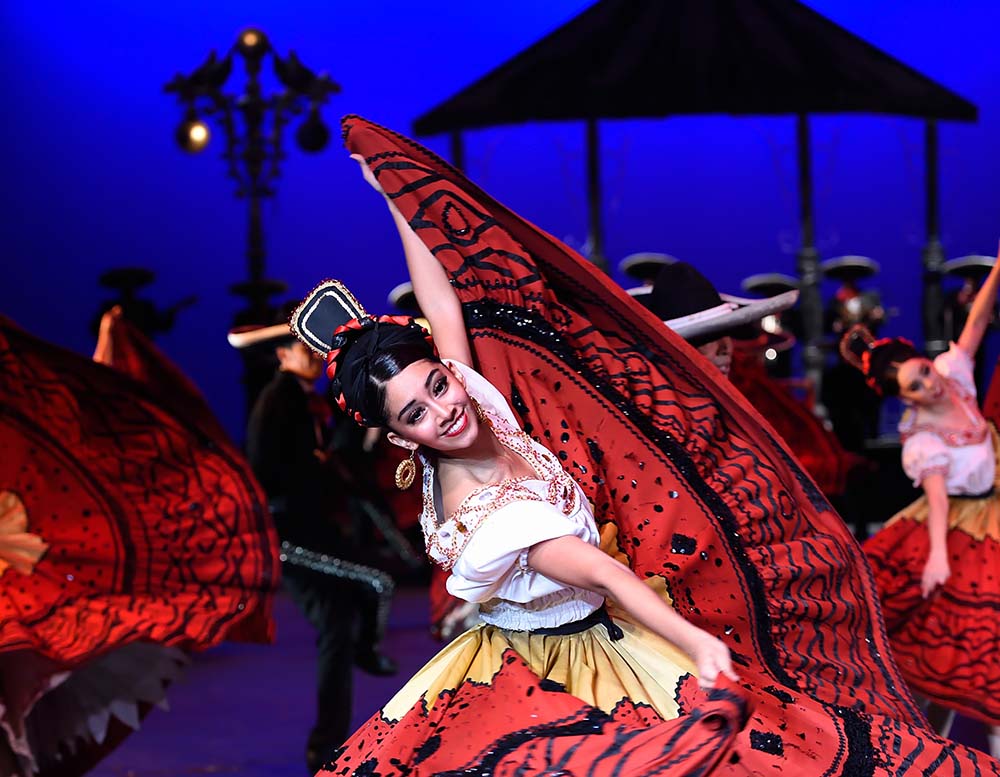
2021-22 SEASON

March 16, 2022
7:30 PM
Smith Theatre
Founders
AMALIA HERNÁNDEZ NAVARRO
NORMA LÓPEZ HERNÁNDEZ
Artistic Director
VIVIANA BASANTA HERNÁNDEZ
General Director
SALVADOR LÓPEZ LÓPEZ
Artistic Director
VIVIANA BASANTA HERNÁNDEZ
Artistic Coordinator
Flavio Carlos Antunez Tiburciov
PR & Manager
Laura Becerril Ortiz
Production Manager
Rafael Mendoza Baltazar
Lighting Director
Roberto Carlos Arellano Ramos
Wardrobe
Jose Barrios Gomez
Sound Chief
Julio Cardenas Garcia
Wardrobe
Pedro Cedillo Jiménez
Stagehand
Aldo Misael Lopez Cedillo
Ariana Cavett
Norma Lorena Fernández Romero
Miriam Andrea Flores Osnaya
Alejandra Itzel García Alejandre
Esmeralda Jazmín Hernández Fierros
Andrea Jaime Villanueva
Sofía de Jesús Larrañaga Castillo
Arcelia Danae López Lara
Mariant Monserrat Martínez Vázquez
Laura Victoria Rea Paulino
Jessica Alejandra Resendiz Rodríguez
Adriana Sánchez Ramírez
Sofìa Segura
Ana Paola Zamacona Licona
Marco Antonio Aguirre Macías
Ernesto Alejandro Arellano Ruiz
Ricardo Alejandro Barranco Omaña
Abraham Bravo Ruiz
José Isaac García Marín
Edson Jair González Gonzaga
Adrián Rogelio Hernández Caballero
Aaron Zalahui Hernández Martínez
Tonatiuh Ricardo Hernández Martínez
Gustavo Lemus Lemus
Daniel Adolfo Rodrìguez
Juan Francisco Rodríguez Torreblanca
José David Rosas Andrade
Oscar Yael Tlatelpa Morales
Jorge Torres Chávez
Miguel Aguilar Salas
Javier Camacho Contreras
Oscar Uriel Canul Tec
Raúl Gavia Ríos
Miguel González Nerey
Wlfred Raymundo May Pech
Hector Medina Ramos
Humberto Medina Ramos
José Medina Ramos
Julio Cesar Mora Nieto
Esteban Salinas Cruz
Gilberto Salinas Cruz
Jesús Salinas Cruz
Adib Wuilliams Toledano Rescalvo
Catarino Torres Contreras

Aztecas (Hijos del sol)
Para esta reconstrucción de danzas rituales aztecas, Amalia Hernández tomó elementos de las crónicas de los conquistadores, los relatos, la escultura y la cerámica, así como de los códices. Este ballet se compone de la danza fúnebre del rey Ahuizótl, viene enseguida la Danza de los Sacerdotes, en honor a Moctezuma II, continúa la Danza de las Doncellas, después la Danza de la Guerra y finaliza con la Danza de la Celebración.
Amalia Hernández took diverse elements from the conquerors' chronicles, sculptures, ceramics, and codices to reconstruct these Aztec ritual dances. This ballet is divided into four dances, the "Dance of the Priests", in honor of Moctezuma II, the "Dance of the Maidens", the "Dance of War", and the "Dance of Celebration".
Sones Antiguos de Michoacán
Esta pieza es un brillante mosaico de bailes y canciones de Michoacán, y una de las coreografías más importantes de Amalia Hernández, pues cambió el rumbo de su carrera, así como el de la danza mexicana. Sones Antiguos de Michoacán combina las técnicas de la danza moderna y clásica para adaptarlas a la danza folclórica; es una evocación del movimiento capturado en el contexto etnográfico. La coreografía es considerada por su creadora como la primera obra inspirada en el folclor, desarrollada de una forma teatral y continúa vigente no solo en el repertorio del Ballet Folklórico de México, sino también como inspiración para otras compañías y agrupaciones de danza folclórica mexicana.
This piece is a brilliant mosaic of dances and songs from Michoacán, and one of the most important choreographies of Amalia Hernández, since it changed the course of her career, as well as Mexican dance. Sones Antiguos de Michoacán combines the techniques of modern and classical dance. The choreography is considered by its creator as the first work inspired developed theatrically and remains not only in the repertoire of the Ballet Folklórico de México but also as an inspiration for other Mexican folk dance companies.
Tarima de Tixtla
Basado en las danzas originarias del estado de Guerrero, Tarima de Tixtla es una de las coreografías más coloridas y alegres en el repertorio del Ballet Folklórico de México. Aquí retumba el eco del zapateado en latarima, enfatizando así, con el ritmo vertiginoso de la alegría, el calor de las almas guerrerenses y la picardía que se sugiere en los movimientos de las bailarinas; ese ajetreo de las faldas y el diálogo que se establece a través de la punta y el talón de los intérpretes.
Based on the original dances of Guerrero, Tarima de Tixtla is one of the most colorful and cheerful choreographies in the Ballet Folklórico de México’s repertoire The echo of the tapping shoes shakes the wooden stand, representing with joy the warmth of the people from Guerrero. The swirl of the skirts and the tapping of the dancers’ feet show an incessant dialogue through dance.
La Revolución
Este ballet está dedicado a las soldaderas o Adelitas, mujeres que tuvieron un papel determinante en la Revolución Mexicana, pues trasladaron su vida y pocas pertenencias a los escenarios bélicos. En rápido contraste se ve a los aristócratas en una alegre celebración, cuando un grupo de rebeldes irrumpe en la fiesta, levantándose en armas para marchar hacia su irremediable destino: la Revolución.
This ballet is dedicated to the "soldaderas", also called Adelitas, women who had a decisive role in the Mexican Revolution, as they took their lives and few belongings to the war scenes. In quick contrast, the aristocrats are seen in a joyous celebration, when a group of rebels breaks into the party, prepared to fight and march towards their destiny: the Revolution.
La Charreada
Una de las tradiciones más arraigadas de México es la Charrería, que surge de las actividades ecuestres y ganaderas de las distintas comunidades del país. Declarada Patrimonio Inmaterial de la Humanidad por la UNESCO, la charrería es un arte y disciplina en la que hombres y mujeres demuestran su valor en las suertes deportivas que provienen del trabajo que se realizaba en las antiguas haciendas de México. Para mantener su popularidad, surgieron asociaciones que mantienen esta tradición vigente a través de las charreadas, que se ejecutan en los lienzos y permiten a los espectadores admirar las destrezas de los charros y jinetes.
One of the most deeply rooted traditions in Mexico is the Charreria, which arises from the equestrian and livestock activities of the different communities of the country. Declared Intangible Heritage of Humanity by UNESCO, Charrería is an art and discipline in which both men and women compete, wearing colorful Mexican costumes trimmed in silver studs. To maintain its popularity, associations were created and also the “Charreadas”, which can be considered as a Mexican rodeo, as well as a highly recognized sport with strict rules and lots of competitions that shows the skills of the “charros” and horsemen.
Fiesta en Tlacotalpan
La danza y la música jarocha tienen una fuerte influencia de la cultura española, es por eso que los bailes están compuestos por movimientos zapateados, característicos del flamenco. Esta fusión se puede apreciar en todo su esplendor durante la celebración de la Virgen de la Candelaria, donde las calles se llenan de mojigangas, bailadores de fandango, jaraneros y bellas mujeres que visten el típico traje veracruzano.
Spanish culture has a strong influence on Jarocha dance and music, which is why there is percussive footwork in every choreography, a distinctive move of flamenco. This fusion can be appreciated during the celebration of the Virgen de la Candelaria, where the streets are filled with mojigangas, fandango dancers, jaraneros, and beautiful women who wear the typical Veracruz costume.
La vida es un juego
Basado en los originales juegos y juguetes mexicanos. Es una sátira que narra un juego controlado por un diablo muy carismático, que maneja a los personajes como si fueran marionetas manipulando las cuerdas para determinar su destino. Realidad y fantasía intervienen cuando el diablo usa a Cupido y a la Muertecita para desarrollar el enredo entre el novio, la novia y el amante. Todo al son de música de feria y fiesta.
This dance is based on Mexican toys and games. The game is controlled by a very charismatic devil that handles all characters as if they were marionettes and with their cords, he manipulates the way to determine their destiny. Reality and fantasy interact when the devil uses both, “Cupid” and “Death” to perform a tangled love story between a bride, her groom and her lover.
Danza del Venado
La Danza del Venado es la representación emblemática del estado de Sonora y es considerada Patrimonio Cultural Inmaterial de la Humanidad por la UNESCO. La Danza del Venado forma parte del rito que se realiza en vísperas de las expediciones de caza y reproduce con asombrosa fidelidad los movimientos de la presa.
The Deer Dance is an emblematic representation of the state of Sonora and is considered an Intangible Cultural Heritage by UNESCO. The Deer Dance is a ritual performed before the hunting expeditions and reproduces the movements of the prey with amazing fidelity.
Fiesta en Jalisco
El estado de Jalisco es la tierra de los Charros, las Chinas y el Mariachi, símbolos de la identidad mexicana y herencia del mestizaje. El brillante folclore jalisciense envuelve en su música, en sus bailes vigorosos y refinados, en sus trajes multicolores y deslumbrantes, lo más noble y puro de la cultura mexicana.
The state of Jalisco is the land of the Charros, the Chinas, and the Mariachi, powerful symbols of Mexican identity. Pure Mexican culture is shown in the brilliant folklore of Jalisco, its music, its vigorous and refined dances, and in its dazzling and multicolored costumes.

Amalia Hernández fue una bailarina y coreógrafa, fundadora en 1952 del Ballet Folklórico de México. Desde muy joven inició un largo trayecto por la cultura mexicana que la llevaría a rescatar las danzas tradicionales de los diversos rincones de México. Ella logró proyectar ante el mundo la belleza de las diferentes regiones de nuestro país a través del movimiento, desde las culturas precolombinas, las influencias españolas en la época del virreinato hasta la fuerza popular de los tiempos revolucionarios.
Con sus primeras presentaciones en 1952 obtuvo el reconocimiento del público como representante cultural de México. Su gran éxito logró establecer al Ballet en el Palacio de Bellas Artes como su sede permanente a partir del 11 de octubre de 1959.
Con más de 30 millones de espectadores e innumerables reconocimientos, el legado artístico de Amalia Hernández permanece vigente gracias a las más de 120 coreografías originales y con gran rigor técnico, elaborados trajes típicos y artistas de primer nivel, consolidándose como la mejor compañía del mundo en su género.
Amalia Hernández was a dancer and choreographer, founder of the Ballet Folklórico de México in 1952. From a very young age, she began a long journey through Mexican culture that would lead her to rescue the traditional dances around Mexico. She managed to project to the world the beauty of our country through movement, from pre-Columbian cultures and Spanish influences to the revolutionary times.
With her first performances in 1952, she obtained public recognition as a cultural representative of Mexico. Her great success established the Ballet in the Palace of Fine Arts as its permanent venue since October 11, 1959.
With more than 30 million spectators and countless recognitions, Amalia Hernández's artistic legacy remains valid thanks to the more than 120 original choreographies with great technical difficulty, elaborate typical costumes, and first-rate artists, consolidating the Ballet as the best dance company in the world in its genre.
Ballet Folkórico de México is produced by CAMI Music LLC

Be prepared to be swept away. The arts possess the unparalleled power to inspire, educate, liberate, and transform. With roots stretching deep into the history of human culture, performances invite us to set aside the constant hum of our daily routines and gather together to envision, to imagine, and to be astonished.
After a period of reduced live performances, we are delighted to raise the curtains on an extraordinary season at The Noorda Center for the Performing Arts, the leading star of UVU’s campus and a hub for the arts in Utah County. There is a special energy in The Noorda, perhaps because it wasn’t long ago that a performing arts center was just a dream. Now in our third season (hopefully our first uninterrupted, in-person season), we are overjoyed to welcome you to our pristine and inspiring spaces.
The event you will experience tonight is the result of countless hours of practice, study, and rehearsal from acclaimed faculty, award-winning guest performers, talented students, and renowned guest artists. In the School of the Arts, we seek to educate and inspire audiences and communities through bold and compelling programming as well as world-class performances. All of this connects deeply to our academic mission.
On behalf of the performers and all those who worked so hard behind the scenes to make this event a reality, thank you for joining us. You are the reason we do what we do – your interest, your energy, your awe. Please enjoy the performance and don’t forget to allow yourself to be swept away.
Courtney R. Davis, J.D., M.A.
Dean, School of the Arts
Utah Valley University acknowledges that we gather on land sacred to all Indigenous people who came before us in this vast crossroads region. The University is committed to working in partnership—as enacted through education and community activities—with Utah’s Native Nations comprising: the San Juan Southern Paiute, Paiute Indian Tribe of Utah, Uintah & Ouray Reservation of the Northern Ute, Skull Valley Goshute, Confederated Tribes of the Goshute Reservation, Northwestern Band of Shoshone Nation, Hopi Tribe, Navajo Nation, Ute Mountain Ute-White Mesa Community, and urban Indian communities. We recognize these Native Nations and their continued connections with traditional homelands, mountains, rivers, and lakes as well as their sovereign relationships with state and federal governments. We honor their collective memory and continued physical and spiritual presence. We revere their resilience and example in preserving their connections to the Creator and to all their relations, now and in the future.
With this statement comes responsibility and accountability. We resolve to follow up with actionable items to make the School of the Arts at UVU and The Noorda Center for the Performing Arts an inclusive, equitable, and just space for all. There is much work to be done, and we are committed to putting these words into practice.
The Circle is an elite group of arts supporters at The Noorda. Our goal is simple: to create a sphere of influence that unites those who wish to have a significant impact upon the performers, patrons, and students who are transformed in our center for true artistic collaboration. Your contribution and support will make this impact by enabling The Noorda to bring the greatest talent from across the world through its doors. While here, these performers and artists will collaborate with students, the community, and our youth. Many will set aside time to visit with Circle Members at exclusive VIP events.
Join The Circle today. Call 801-863-8345 or email Alex Malone [email protected] for more information.
Mr. & Mrs. Alan and Karen Ashton
Mr. Bruce Bastian
Mr. & Mrs. Darren and Lisa Bastian
Mr. & Mrs. Jeff and Cristi Bastian
Mr. & Mrs. Rick and Heather Bastian
Mr. & Mrs. Robbie and Amy Bastian
The Church Of Jesus Christ Of Latter-day Saints
dōTERRA
Mr. & Mrs. Kem and Carolyn Gardner
Barbara Barrington Jones Family Foundation
The Ray and Tye Noorda Family Foundation
Nu Skin
OC Tanner
Mr. & Mrs. Scott and Karen Smith
Utah County Government
Mr. Kim Wilson and Mrs. Gail Miller Wilson
Zions Bank
Clyde Companies
Mr. and Mrs. Paul and Jeanette Clyde
Mayor & Mrs. Guy and Paula Fugal
Mr. & Mrs. Duane and Erlyn Madsen
Mr. & Mrs. Jeff and Nancy Flamm
Mr. & Mrs. Brent and Cheri Andrus
Ms. Mary Crafts
Mr. & Mrs. Brad and Becky Caldwell
Dr. Carolyn Rasmus